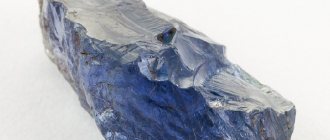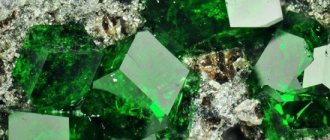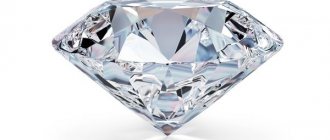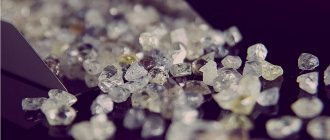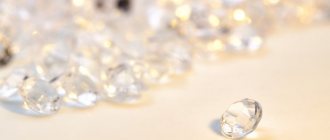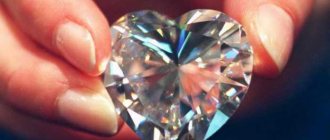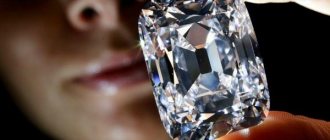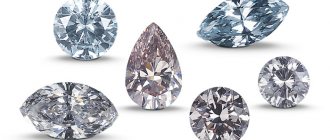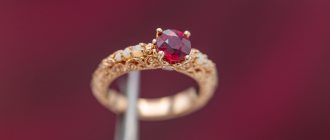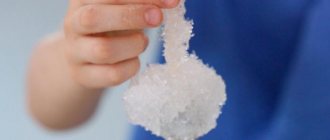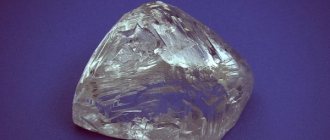Diamond is a mineral of particular hardness, the most expensive of natural gems. Some types of diamonds with bright colors are especially valued. Wine-yellow, golden, cherry and ruby stones are held in special esteem. The rarest colors of diamonds: black, purple, green.
Diamonds are mined from rocks. To obtain one carat of valuable stone, 250 tons of ore are processed.
SIZE MATTERS
The morphological characteristics of diamond are varied. Scientists distinguish poly- and monocrystalline forms of nuggets, which affect the strength of the mineral.
The mineral is so rare that large deposits can be counted on the fingers of one hand. Rich mines have 3 to 6 stones per 1 ㎥.
The weight of a diamond affects its value. Having found an apricot-sized diamond, the owner will purchase the plant with the funds received from it.
Diamonds with amazing clarity and brilliance are highly prized.
Diamond size and weight
Diamond crystals vary from microscopic (discernible only with a telescope) to large ones, the size of a fist. Researchers discovered a nugget weighing 0.63 kg (more than 3,120 carats) in the bowels of South Africa.
Diamonds weighing more than 15 carats are considered rare stones, while diamonds weighing more than 101 carats are considered rare. Often these specimens are given names.
Gemological Institute of America (GIA)
As can be seen from the table, this system uses a letter scale. Unusual or fancy colors are assessed individually as they are quite rare.
- This is important: How to determine the authenticity of a diamond
Russia has its own grading scale, which uses a more precise classification divided by cut and weight: up to 0.29 ct, from 0.3 ct. The relationship between these two systems is presented in the table.
DIAMONDS ARE PRECIOUS AND NOT VERY PRECIOUS
There are the following types of diamonds:
| Jewelry | Can be processed and cut, there are no defects |
| Technical | The structure is damaged, is not used for making jewelry, they have multiple inclusions. |
It is not for nothing that diamond is considered the most expensive mineral - most of the stones are used for technical needs. Only 20% comes from jewelry. This is due to the difficulty of extracting high quality stones without inclusions.
Among a million stones, there is hardly one nugget worth the attention of jewelers. After processing, the nugget becomes half its original size: this is due to a specific cut that turns 50% of the nugget into dust.
Cut shapes
Who is suitable according to their zodiac sign?
Diamond is a stone of the Fire element, therefore its energy is ideally compatible with the energy of the signs of the Fire element: Aries, Leo, Sagittarius . For representatives of this trine, the stone improves life “on all fronts,” but only if they are pure in soul.
Some astrologers believe that it is also suitable for Libra and Capricorn .
This mineral has a neutral attitude towards the other signs of the zodiac (except those related to the element of Water). But representatives of the “water” trine, Scorpio, Pisces, Cancer , are not recommended to wear it. This is especially true for Pisces - a nugget can take away their psychic energy. The following can be recommended for this sign as talismans and amulets: opal, blue agate, amethyst, euclase, rose quartz, aragonite, spinel, jasper, orthoclase, anhydrite (angelite), prasiolite, pearls.
In addition, Pisces, Scorpio and Cancer are suitable for:
- Moonstone;
- ammolite;
- ammonite;
- Labrador;
- Belomorite.
Cancer also has individual preferences for the following stones: cat's eye, pearl, alexandrite, aventurine, tektite, chrysoberyl, petersite. And for Scorpio - aquamarine, topaz, opal, alexandrite, rhodochrosite, sarder, carnelian (its variety is cornelian), red garnet, unakite, chrysoberyl, howlite, kunzite.
Zodiac astrology specialist Luis Hamon has a special opinion about black diamond. He believes that such a stone can be a lucky stone for Pisces , but only those born on March 8, 17 and 26 , as well as for Aquarius , whose birthday is February 8, 17 and 26 .
TYPES OF CUT
Clarity and color of a diamond play a significant role in the value of a diamond, but not the key one. For a nugget to become refined and refined, the skill of the jeweler is important.
We recommend: TOP-13 shades of TOPAZ
In the diamond industry, it is customary to process raw materials in several stages before sending them to the shelves:
- CLEAVING THE CRYSTAL. The diamond is scanned using X-rays, in this way finding damage in it that is invisible to the human eye, which is required to facilitate cutting the diamond.
- REARING OF MINERALS using a lathe. The process is designed to form edges and corners on the stone.
- TREATMENT. The process takes place on iron polishing wheels, which are sprinkled with special diamond powder. The procedure ensures deep cutting of the mineral.
- POLISHING. A final treatment process that allows the stone to shine brighter and deeper.
Manufacturers use several shapes in the diamond cutting process. The specific design of the jewelry determines how the potential of the stones will be revealed. Any cut must meet the requirements for size and angles of inclination.
Color and purity table
The following classical methods of stone cutting are distinguished:
- ROUND. Tolkovsky's invention. Since then, the round cut has been the most popular and versatile. However, during the process the material is subjected to merciless processing, as a result of which the mineral loses most of its weight.
- PRINCESS. Square shape with sharp corners. When grinding, a minimum amount of waste is observed.
- PEAR. The sophisticated shape looks good with earrings, pendants and rings. A pear-shaped stone visually lengthens your fingers.
- MARQUISE. The elongated boat shape adds charm, aristocracy, and sophistication to a woman.
- OVAL. The oval shape of the stone creates an emphasis on the desired part of the body: ears, neckline, hands.
- HEART. Processing the heart shape requires multi-step, complex work. Therefore, such stones are more expensive than others.
- EMERALD. The shape of the stone is rectangular, with an octagonal cut. A less common option due to the extraordinary refraction of light.
- USHER. Square shape, multi-stage, with multi-tiered refraction of light.
Jewelers are working on creating other cuts, using different processing technologies.
Diamonds of pure water
You often hear the phrase “a stone of pure water” or “a diamond of pure water.” This term refers to perfectly transparent and high-quality stones, mainly diamonds and, accordingly, diamonds. There are different versions of the origin of this term. Perhaps the most ridiculous one is that smugglers hid diamonds in containers of water, in which such stones are supposedly not visible.
In fact, diamonds or diamonds, even the most transparent ones, are clearly visible in water. In order for a substance to be invisible in water, it must have a similar refractive index to it. The refractive index of water is 1, glass is 1.5, and diamond is approximately 2.4. Thus, a diamond is more visible in water than glass, and it is impossible to hide it there. Most likely, the term “pure water diamond” appeared as a designation of uniform transparency and the absence of defects and coloring in the stone, which corresponds to the properties of crystal clear water.
ALL STONES - CATALOG | DIAMONDS (DIAMONDS) - CATALOG
Physical properties of diamond | Chemical properties of diamond | What are the different shapes of diamond crystals? What is a black diamond? | The largest diamonds - the whole list | Huge Diamond - Golden Jubilee | The largest diamond in history, the Cullinan and its diamonds | Meaning assigned to a diamond
Share this article with your friends
Works by designers from the JEWELIRUM catalog
- Co.Cos Jewelry
- Co.Cos Jewelry
- Taiga Jewelry, Tomsk
- Taiga Jewelry, Tomsk
- Ilya Maksimov, Crimea
- Ilya Maksimov, Crimea
- UBIRING
- UBIRING
- Diamonds are Forever
- Diamonds are Forever
- Rings in natural style, Sergacheva Jewelery
- Earrings with pearls, Sergacheva Jewelery
- Cabochon ring, Minty Sky
- Fly earrings, Minty Sky
- Ring, Precious Park
- Ring, Precious Park
- Snake skin ring, Stoyanova Jewelery
- Chain earrings, Stoyanova Jewelery
- Children's pendant - stick, Matthew&Daniel
- Pendant for a child, Matthew&Daniel
- Bracelet, Svetlana Subbotina
- Ring with Slavic symbols, Svetlana Subbotina
- Indian style ring, Anna Goffman
- Indian style ring, Anna Goffman
- Earrings, ISTA
- Geometric ring, ISTA
- Earrings with enamel, PNJewelry
- Ring with enamel, PNJewelry
- Ring, Khramtsova Jewelry
- Ring, Khramtsova Jewelry
- Wedding rings to order, obruchalki.com
- Wedding rings to order, obruchalki.com
- Earrings, Yuri Bylkov
- Earrings, Yuri Bylkov
- Titanium bracelets, LanaMuransky
- Titanium pendant, LanaMuransky
- Brooch Elephant (after Salvador Dali), THING
- Ring Veil, THING
- Mace earrings, VLADIMIR MARKIN
- Cufflinks, jewelry mechanics, VLADIMIR MARKIN
- Drop-shaped ring, EKATERINA TOLSTAYA
- Drop-shaped earrings, EKATERINA TOLSTAYA
- Necklace with amber, LETA
- Earrings with amber, LETA
- Children's earrings, combinable, FASHBY
- Children's earrings, combinable, FASHBY
- Ring of architectural form, Elizaveta Malafeevskaya MANU_L
- Architectural bracelet, Elizaveta Malafeevskaya MANU_L
- Set Ginkgo Leaf, SHABUT JEWELLERY
- Brooch Wearable porcelain, SHABUT JEWELLERY
- Architectural ring, GEOMETRY
- Brooch, porcelain, GEOMETRY
- Necklace made of polymer clay, LICORNE ART
- Brooch made of polymer clay, LICORNE ART
- Ring, avant-garde, VALERY SEREDIN
- Bracelet, avant-garde. VALERY SEREDIN
- Wooden set, Scandinavian/Japanese minimalism, VLADIMIR SHESTAKOV
- Ring, Scandinavian/Japanese minimalism, VLADIMIR SHESTAKOV
- Earrings, TON ANT
- Ring, TON ANT
- Architectural ring, ANCHOR
- Architectural necklace, ANCHOR
- Earrings, GOHFELD JEWELLERY
- Necklace, GOHFELD JEWELLERY
- Massive ring, YAKISCHIK
- Designer jewelry, YAKISCHIK
- Architectural ring, ONE DAY ART
- Architectural ring, ONE DAY ART
- Brooch, bionics, VALERIYA MARKOVA (TESSA)
- Unclosed ring, bionics, VALERIYA MARKOVA (TESSA)
- Ring, bionics, BEAVERS
- Earrings, bionics, BEAVERS
- Earrings, asymmetry, VAGANOVA JEWELRY
- Airplane ring, VAGANOVA JEWELRY
- Flower ring, ALCHEMIA JEWELLERY
- Set, ALCHEMIA JEWELLERY
- Pendant-cat, ethnic, STUDIO OF ILYA AND VERA PALKIN
- Earrings, STUDIO OF ILYA AND VERA PALKIN
Comments
- Anonymous
Thank you !!! You helped me a lot !!!!!!!!!!!!!!!!!
2 years ago Reply
COLOR PALETTE
The color of a diamond comes in all colors of the rainbow. It is affected by impurities in the diamond, as well as chemical reactions during the formation process. There are unusual colors of diamonds in nature. Among them: yellow, blue, red, green, transparent and others.
Diamond color palette
The stone without color is especially beautiful - transparent. We recommend: COGNAC DIAMONDS
The unusual yellow color is obtained by replacing carbon atoms with nitrogen particles. Dark yellow stones of this color range are the most valuable.
Expensive, exquisite diamonds have red, brown, and pink tints. They are mined in Australia. Scientists do not know how the stones take on an unusual color, which gives the nuggets mysticism and mystery.
Blue stones are obtained by replacing the atoms of the crystal lattice from carbon to boron. The color blue is often created in laboratories.
The color green is produced when it is influenced by radiation waves. Black nuggets are mined from the upper layers of the earth's crust, and its structure is characterized by tiny crystals fused together.
How to spot a fake
Diamond holds the record for the number of its own unlicensed copies. Instead, they may try to slip cubic zirconia to an inexperienced person - a synthetic jewelry stone that is similar in appearance, or even just a piece of glass.
Many people know that a real diamond cuts glass. But many natural stones are capable of this feat, transparent versions of which are also sometimes passed off as diamonds. Therefore, professional appraisers use a special “heat probe” to determine authenticity, which tests the thermal conductivity of the stone. Another method is a special felt-tip pen, which leaves an even line on the surface of the diamond. On another stone or glass, the line appears dotted.
Diamonds
When purchasing a stone in a store, you can try to examine it through a magnifying glass with a twelvefold magnification - in bright light, cubic zirconia will give the effect of visual doubling of the edges. Diamond - no.
SYNTHETIC AND NATURAL
- Jewelers have learned to create synthetic crystals - these are fancy colored diamonds, the shade of which depends on laboratory experiments.
- A synthetic diamond is an exact copy, similar to the original. The structure, properties and other indicators do not differ from those of natural minerals.
- Synthesized diamonds are superior to natural diamonds in terms of hardness, purity, and are better cut.
- Artificial stones are pleasing with the complete absence of defects, unlike their “brothers” (microcracks, inclusions, clouding). At the same time, man-made specimens are cheaper than natural diamonds.
- In connection with the process of obtaining synthetic stones, the names of diamonds have been replenished with new laboratory developments. The first artificial stone was produced in 1950 in Sweden.
Unlike natural stones, synthetic ones are without flaws, but are several times cheaper than natural ones.
Properties
Blue diamond has a special energy. His magic seems to envelop a person, protecting him from illness and trouble.
Magical
The magical properties of the gem include:
- will bring success in any endeavor;
- makes a person more self-confident, gives him courage, courage, endurance, risk-taking in the good sense of the word;
- attracts the attention of the opposite sex;
- reveals hidden talents, gives inspiration;
- helps to improve relationships with others, smooth out rough edges in family relationships, and avoid scandals, quarrels, and misunderstandings.
It is believed that you cannot buy the mineral for yourself. It gives the best effect if it is presented as a gift. In addition, if you give a gem to your loved one, it will awaken feelings, passion in him and preserve the relationship forever.
Medicinal
The importance of the blue diamond in the field of alternative medicine cannot be underestimated. The stone is often used as a healing tool in massage or meditation. The healing properties of the mineral include:
- eliminates the inflammatory process in the body;
- cures skin diseases;
- helps cleanse the blood and saturate it with oxygen;
- stabilizes blood pressure;
- has a positive effect on the circulatory system in general;
- normalizes the mental state of the owner: calms the nervous system, eliminates insomnia, disturbing dreams, fears, anxiety.
In order for a gem to fully exhibit its magical properties, it must be cleaned from time to time. It is enough to hold the stone for a day in clean running water, and it will completely “throw off” unnecessary information that prevents it from expressing itself fully.
Compatibility with other stones
Diamond is not only the most expensive and beautiful noble stone, but also the most freedom-loving and strong.
Finding company is very difficult for him. Only precious stones that are close in price are suitable, and not all of them. For example, among garnets, only pyrope is recognized by this mineral. Ruby and spinel, which belong to the element of Fire, are also suitable for him, as is diamond.
A combination with sapphire will not always be successful, since it is associated not only with the element of Air, but also with the antipode of Fire - Water.
Emerald and pearl are excluded from the list of possible neighbors of a diamond, since they belong to the water element.
Diamonds with earth element stones are not worn - they are too cheap for “royal crystals”, and the energy of Fire will suppress these opaque gems.
All this corresponds to one of the systems that determine the compatibility of stones according to the elements that protect them. “Fire” minerals are friends with each other and with Air stones. On the Internet there are stone compatibility tables compiled in accordance with other systems, and the data in them is different.
